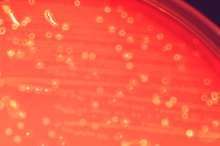Streptococcus anginosus group
| Streptococcus milleri | |
|---|---|
 | |
| Cultures of Streptococcus anginosus on blood agar | |
| Scientific classification | |
| Kingdom: | Bacteria |
| Phylum: | Firmicutes |
| Class: | Bacilli |
| Order: | Lactobacillales |
| Family: | Streptococcaceae |
| Genus: | Streptococcus |
| Streptococcus anginosus group | |
|---|---|
| Classification and external resources | |
| MeSH | B03.510.400.800.872.875.475, B03.510.550.737.872.875.475, B03.510.400.800.872.875.475, |
The Streptococcus anginosus group (SAG), also known as the anginosus group streptococci (AGS) or the milleri group streptococci (MGS), are a group of several species of streptococci with clinical similarities. The group is named after a principal member species, Streptococcus anginosus. The older name Streptococcus milleri (as well as Streptococcus milleri group, SMG) is now pseudotaxonomic, as the idea that these streptococci constituted a single species was incorrect. The anginosus group streptococci are members of the viridans streptococci group.[1] They have been implicated as etiologic agents in a variety of serious purulent infections, but because of their heterogeneous characteristics, these organisms may be unrecognized or misidentified by clinical laboratorians.[2] The unique characteristic of them from other pathogenic streptococci, such as S. pyogenes and S. agalactiae, is their ability to cause abscesses.[3][4]
Species
Members include:[2]
- Streptococcus anginosus
- Streptococcus constellatus
- S. constellatus subsp. constellatus
- S. constellatus subsp. pharyngis
- Streptococcus intermedius
Nomenclature
These non-hemolytic viridans streptococci were first described by Guthof in 1956 after being isolated from dental abscesses. He named these organisms "Streptococcus milleri" in honor of the microbiologist W. D. Miller.[5][6]
Occurrence
The organisms were subsequently recognized as normal flora of the human oral cavity and gastrointestinal tract with the ability to cause abscesses and systemic infections.[7]
References
- ↑ Streptococcus milleri group at the US National Library of Medicine Medical Subject Headings (MeSH)
- 1 2 Ruoff, K L (Jan 1988). "Streptococcus anginosus ("Streptococcus milleri"): the unrecognized pathogen" (PDF). Clinical Microbiology Reviews. 1 (1): 102–108. doi:10.1128/CMR.1.1.102. PMC 358032
 . PMID 3060239.
. PMID 3060239. - ↑ Gossling, J (Mar–Apr 1988). "Occurrence and pathogenicity of the Streptococcus milleri group". Reviews of infectious diseases. 10 (2): 257–85. doi:10.1093/clinids/10.2.257. PMID 3287560.
- ↑ Rashid, R. M.; Salah, W.; Parada, J. P. (1 February 2007). "'Streptococcus milleri' aortic valve endocarditis and hepatic abscess". Journal of Medical Microbiology. 56 (2): 280–282. doi:10.1099/jmm.0.46781-0.
- ↑ Whiley, RA; Beighton, D (January 1991). "Emended descriptions and recognition of Streptococcus constellatus, Streptococcus intermedius, and Streptococcus anginosus as distinct species". International Journal of Systematic Bacteriology. 41 (1): 1–5. doi:10.1099/00207713-41-1-1. PMID 1995029.
- ↑ Verrall, R (November 1986). "The Streptococcus milleri group". Infection Control and Hospital Epidemiology. 7 (11): 558–60. doi:10.1017/S0195941700065334. JSTOR 30146431. PMID 3640746.
- ↑ Mejàre, B; Edwardsson, S (November 1975). "Streptococcus milleri (Guthof); an indigenous organism of the human oral cavity". Archives of oral biology. 20 (11): 757–62. doi:10.1016/0003-9969(75)90048-5. PMID 1061530.